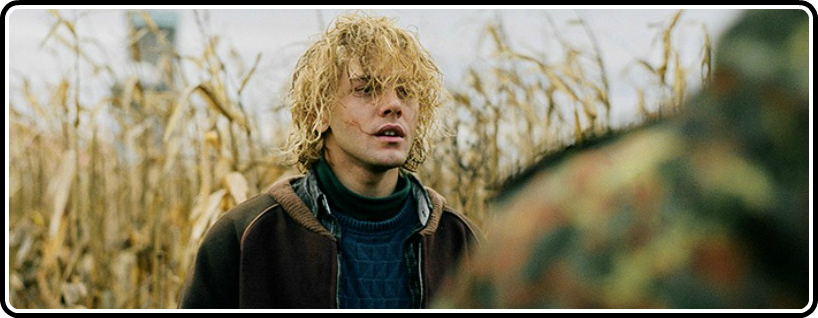
In his 25 never-stops-moving years, Canadian director Xavier Dolan has five films in the can, upping his own accelerated game each time. However one feels about the young polymath, it’s impossible to deny how accomplished he is. To be reductive about it, he’s known for a showy visual flair (what detractors call a ‘film school aesthetic’); a tendency of putting music front and center, with slow-motion always in tow as relationships are dissected. But with his fourth film, Dolan departs from most of this and shows us what else he can do. Turns out it’s quite a lot. With Tom at the Farm, he’s swimming in the nefarious waters (or rather corn stalks) of the genre film (in this case, a thriller), adapting himself without ever losing himself.
When Tom (Xavier Dolan) arrives at his deceased lover’s family farm it is, at first glance, abandoned. Gradually, he is introduced to Guy’s spindly mother Agathe (Lise Roy). Soon after that, Tom learns that Guy had a brother, the volatile and strangely needy Francis (Pierre-Yves Cardinal). Turns out Tom’s arrival threatens to blow the cover off the alternate heterosexual history Frances concocted of Guy for Agathe’s sake. Frances wants Tom gone, while Agathe agonizes over why ‘Sara’ (Évelyne Brochu) didn’t show up to the funeral. And things only get more complicated from there.
I still haven’t seen Xavier Dolan’s first two films, but from what I know about them, and having seen Laurence Anyways, it’s safe to say this is a significant departure; certainly more austere (by his standards) both in content and aesthetic. His penchant for music video executions has been whittled down, replaced by a streamlined, but equally present, Bernard Herrmann-like score by Gabriel Yared. So what can Dolan do with a genre film? He keeps the vague structure of a chamber piece psychological thriller. The aforementioned heightened string score, withheld secrets, violent sex-tinged dynamics, slowly boiling tensions, and an isolated location are just some of the tropes present. But there’s no throughline of conventionality. The recognizable signposts are there, but it’s to support what is at the center; a twisted obscurity.
Tom at the Farm isn’t narrative heavy, nor is it really a character study. It’s all about the warped locked-in dynamic at the center between Tom and Francis; the grief, repression, sadomasochism, and the mutual acts of substitution occurring between the two. Tom is not so much trapped at the farm, as he is a willing contributor and guest. Francis bullies Tom, asserting dominance at every turn, physical abuse of some kind usually a guarantee.
How Tom feels about this is, at first, clear-cut. He’s frightened, intimidated, and angry. But soon a kind of Stockholm syndrome develops; we stop identifying with Tom and start questioning his reasoning, and then he starts questioning his own reasoning. Francis, Agathe, the farm, the chores; it all has a connection to Guy which Tom, for better or worse, isn’t willing to part from just yet. Milk the cows. Eat the pie. Do what Guy did.
How Francis feels about Tom is, at first, also clear-cut. He wants Tom to keep the heterosexual deceit going for his mother, and for him to leave. But his motives soon become conflicted, and a counterintuitive strand of neediness emerges. They need each other, and neither can quite pinpoint why, though Tom at least seems aware of the raw materials present. All this may lead to a conventional climax, but getting there is captivating business.
Dolan puts himself front and center, the majority of the frames filled with his own face. But guess what? It works. He is exceptional at showing the different cuts of Tom’s fragility. Pulling constant focus on Tom heightens the gradual elusiveness of the character, thrusting it in our face. The most striking shot emphasizes his binary tailspin, putting that ambiguity at the center. It’s a long take of Tom behind a screen door. One can’t help but be reminded of Jack Torrance by the way he’s lit. He pushes his flaxen locks against the screen, eyes dead and looking out. The longer the take lasts, the more uncertain we are about him.
Tom at the Farm is enveloped by the distinctly smothered absence of homosexuality. The alternate hetero history ‘protector’ Francis makes up for ‘protected’ Agathe’s sake strikes as rickety and outrageously needless. And isn’t that the point? That the never-directly-addressed homophobia underneath such an elaborate lie is the impetus this thriller hinges on sort of says it all. Americanized touchstones mark everything. The dirty and desolate muddy golden-chestnut palettes hold in Dolan’s face. Francis and Agathe are introduced hesitantly by the camera, obscured in close-up for some time, creating mystery around them, before bringing them full-on into the narrative. The aspect ratio changes three times, for brief intervals. They function as a sharpening of focus, black bars of signifying the momentary internal clarity of desire; tussling that literally changes the frame.
Even when Xavier Dolan is taking it down a notch, as with Tom at the Farm, he’s still doing things as audacious and playful as changing aspect ratio. Not to signify time periods as in this year’s The Grand Budapest Hotel, but as sexually charged signifiers, a black bar erection if you will. That this formal inventiveness still shines through as he tests the limits of his own prowess, both in restraint and indulgence is why he’s become such a commendable presence in modern cinema.





![Bergman Island (The Criterion Collection) [Blu-ray]](https://criterioncast.com/wp-content/uploads/2022/11/bergman-island-the-criterion-collection-blu-ray-400x496.jpg)
![This Is Not a Burial, It’s a Resurrection (The Criterion Collection) [Blu-ray]](https://criterioncast.com/wp-content/uploads/2022/11/this-is-not-a-burial-its-a-resurrection-the-criterion-collection-blu-ray-400x496.jpg)
![Lars von Trier's Europe Trilogy (The Criterion Collection) [The Element of Crime/Epidemic/Europa] [Blu-ray]](https://criterioncast.com/wp-content/uploads/2022/11/lars-von-triers-europe-trilogy-the-criterion-collection-the-element-of-400x496.jpg)
![Imitation of Life (The Criterion Collection) [Blu-ray]](https://criterioncast.com/wp-content/uploads/2022/11/imitation-of-life-the-criterion-collection-blu-ray-400x496.jpg)
![The Adventures of Baron Munchausen (The Criterion Collection) [4K UHD]](https://criterioncast.com/wp-content/uploads/2022/11/the-adventures-of-baron-munchausen-the-criterion-collection-4k-uhd-400x496.jpg)
![Cooley High [Criterion Collection] [Blu-ray] [1975]](https://criterioncast.com/wp-content/uploads/2022/11/cooley-high-criterion-collection-blu-ray-1975-400x496.jpg)